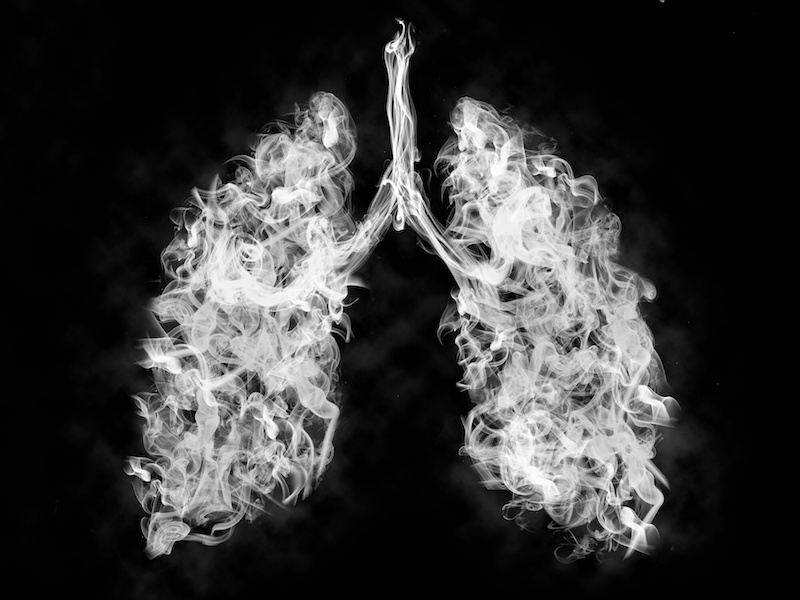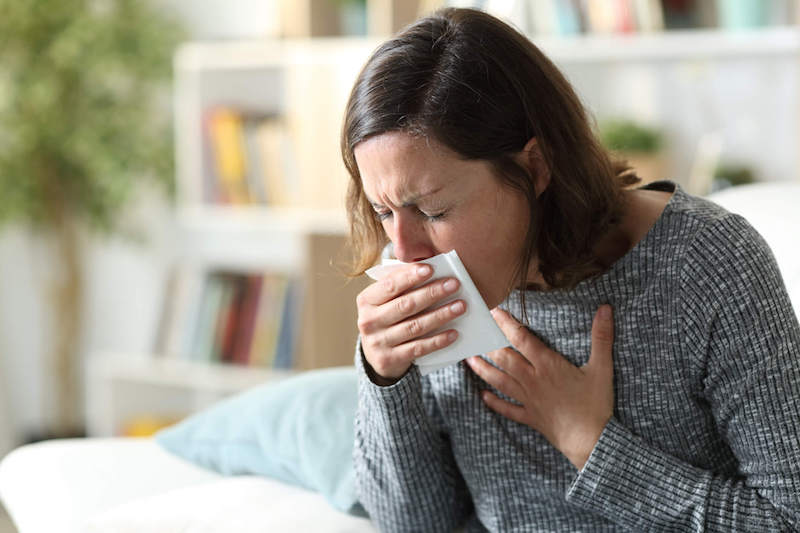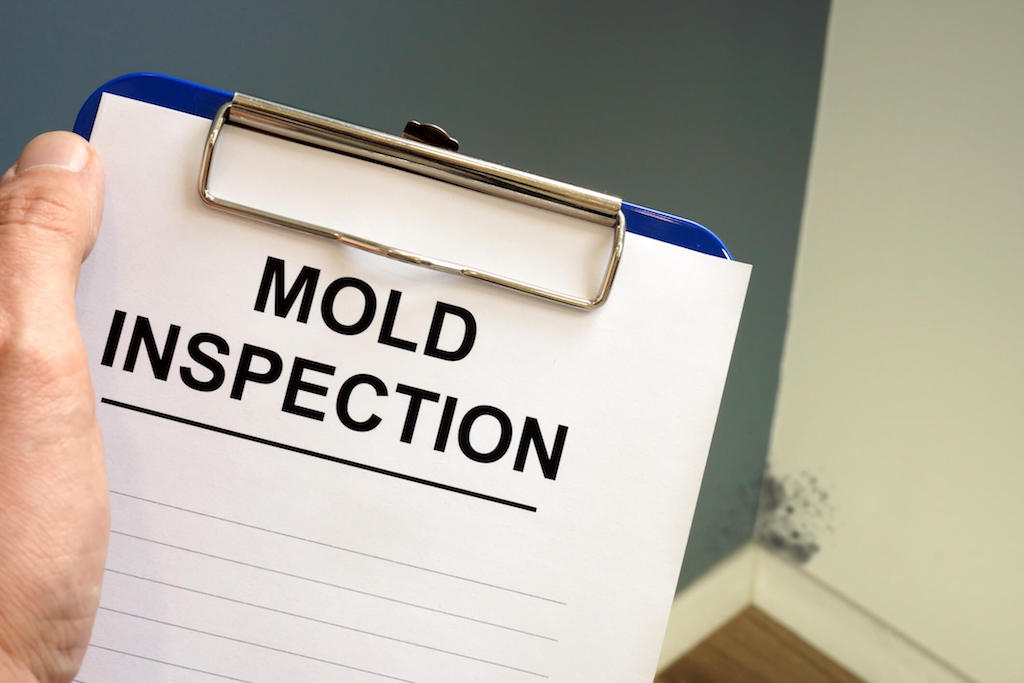The lungs are one of the most vital parts of the human body. Their existence is massively important for us to live our everyday lives. They’re tasked with supplying the rest of the body with life-sustaining oxygen as well as a whole list of other crucial jobs which is pretty great for our wellbeing.¹ And, the best part of all, they do these jobs on their own; even breathing! Receiving signals from our medulla oblongata (a part of our brain), they’re triggered to automatically inhale and exhale without us having to consciously make it happen.² Hence the saying, “As easy as breathing.”
Their role in our continued health and survival is why doctors harp on us to keep them in tip-top shape. At the top of their list is making sure we reduce any exposures or actions that could cause these organs harm, like staying away from asbestos, not smoking, and being aware of Aspergillosis’ effect on our lungs.

Wait… Asper-what?
Don’t worry, you’re not the only one! Unless you caught that one episode of House where it was a potential diagnosis they were ruled out, most of us probably haven’t heard of Aspergillosis or how it can impact our lungs.
So what is it? It’s an infection/disease caused by a type of mold. This fungus can make its way right into our lungs and cause a long list of health problems including some serious damage to our rockstar organs that enable us to breathe.
Kind of makes you wonder why society hasn’t heard about this infection before when we’re often steered away from other potentially harmful environmental factors. Right?
What We Know Harms Our Lungs
As we grew up, school systems and doctors alike continually warned us about substances that could damage our lungs. From outdoor pollution to asbestos and smoking, we learned early on how important it was to keep these vital organs safe.
Smoking tobacco products, in particular, found its way into the forefront of maintaining healthy lungs. I’m sure most of us remember those cringe-worthy commercials, documentaries about people surviving through lung cancer, and real-life comparisons of healthy lungs versus smoking lungs. Images like that tend to stick in your mind, even decades later.
Their fear tactics make sense though. Smoke does indeed cause serious harm to our lungs and in turn, affects our everyday life.³ Bruce Willis’ character in Die Hard 2: Die Harder (what a great name) wasn’t kidding when he said he needed to lay off the cigarettes so he wasn’t struggling to breathe while running!
Just one inhalation of a cigarette introduces over 7,000 chemicals into our poor lungs who are just trying to go about their day filtering in oxygen and releasing chemical waste like carbon dioxide.⁴ When you factor in that most cigarettes take an average of 6.8 puffs to go through, that’s a serious amount of chemicals to introduce to your lungs; and that’s only from one cigarette…⁵ Vaping also falls into this harmful category, packing an intense 2,000 chemicals per inhalation.⁶
When you see individuals coughing after taking that first puff of the tobacco/nicotine product, it’s probably from their outraged lungs saying, “This is public enemy number one, get it out!” I don’t blame them!
Continual use of these products, or even prolonged exposure to secondhand smoke, can cause a range of health issues, particularly in the lungs. These individuals may potentially experience emphysema, chronic obstructive pulmonary disease, lung cancer, and/or damage to the cilia (the super important hair-like structures inside lungs that push out mucus).⁷’⁸ Keep in mind, that’s just the effect smoking can have on the lungs. There’s a long list of other adverse health effects caused by tobacco/nicotine as well like heart attack, stroke, and other respiratory cancers.
So, to put it simply, smoking is bad. As we all know! The point is, we know the extent to which smoking can impact our lungs. We’ve been told about the effects for most of our lives.
What about environmental factors like mold, though? Chances are, most individuals have no idea. In fact, when asked about the harmful effects of mold exposure, most people will more than likely say they’ve heard that only “toxic black mold” is a problem and any other mold exposure isn’t that bad. That’s if they’ve heard about mold exposure’s relationship to health at all.
With the extent to which mold can impact our health, like Aspergillosis’ effect on the lungs, that’s just not okay.
So, What Exactly Is Aspergillosis?
Aspergillosis is developed by inhaling spores from a common mold called Aspergillus.⁹ Pretty easy to see where they got the name from! This disease isn’t just a one-size-fits-all, though. Researchers have categorized different types of diseases associated with Aspergillosis and use the word as a blanket term to represent them all.¹⁰’¹¹’¹²’¹³ Each causes a range of bodily responses and develops differently.

These forms include:
Allergic Bronchopulmonary Aspergillosis (ABPA)
ABPA is a lung disease that occurs when the body experiences an allergic reaction to Aspergillus, leading to inflammation in the lungs. Symptoms include wheezing, shortness of breath, cough with brownish flecks or blood, fatigue, and chest tightness.
Allergic Aspergillus Sinusitis
This disease is caused by a reaction to Aspergillus that leads to inflammation in the paranasal sinuses. Symptoms include difficulty breathing, headache, stuffiness, congestion, facial pain, and intermittent nasal discharge.
Azole-Resistant Aspergillus fumigatus
This occurs when a species of Aspergillus, Aspergillus fumigatus, becomes resistant to azole antifungal medications. Without medication to stop it, the fungus will continue growing inside the body. Which is a bit gross when you think about it… Those suffering from this disease will continue to experience symptoms even after treatment so things like coughing and shortness of breath will persist.
Aspergilloma
Aspergilloma occurs when a ball of Aspergillus begins growing inside the body. It’s also known as a “fungus ball” in the medical community. That’s not traumatizing at all… Unfortunately for us, it can happen in real life even though it sounds like an episode of Grey’s Anatomy! Typically, this ball of mold occurs in a cavity within the sinuses or lungs. Common symptoms of this include coughing that brings up blood, chest pain, shortness of breath, wheezing, and fatigue.
Chronic Pulmonary Aspergillosis
This involved the slow destruction of the lungs by an Aspergillosis infection, leading to cavities and nodules within the lungs. It can be caused by one of those fungus balls, or it could stem from just the infection itself. Those suffering from this often present with a chronic cough, weight loss, coughing up blood, fever, and fatigue.
Invasive Aspergillosis
This aggressive disease occurs when the infection quickly spreads through the bloodstream to other parts of the body like the brain, heart, skin, or other organs. It’s the express lane we do not want to be taken for the good of our health. Symptoms depend on which organ systems are affected but often include fever, chest pain, fatigue, and shortness of breath.
Cutaneous (skin) Aspergillosis
Cutaneous Aspergillosis develops when Aspergillus makes its way inside the body through a wound or a burn and causes these areas to become infected. Symptoms include fever, changes to the look of the wound, swelling, and tenderness.
Taken as a whole Aspergillosis’ effect on the lungs and our health as a whole is not something we want to mess with!
Diagnosing these diseases typically involves a look at the medical history, examining the symptoms, and then an array of tests such as blood work, CT scans, X-rays, and/or biopsies. Early detection is one of the best ways to quickly and efficiently treat this disease.
Treatment for Aspergillosis varies based on several factors, including which form was developed, the patient’s overall health, and the extent of infection among others. Generally, though, treatment plans fall into taking a series of antifungal medications, oral corticosteroids, bronchial artery embolization, and even surgery.

The tricky part of treatment usually occurs with preexisting conditions and how these play a role in fighting off the infection. While some individuals may experience mild symptoms that can be treated fairly simply, others may experience serious side effects that could end in loss of life. The potential severity of this disease makes it incredibly important to understand how Aspergillosis can occur, what signs to look for so treatment can begin early, who is most at risk for contracting it, and how to actively work towards preventing it.
The last part is dicey because you can’t eliminate all potential exposure. Someone particularly susceptible could encounter a single lucky Aspergillus spore while going to the grocery store and start experiencing Aspergillosis’ effect on the lungs from that encounter. The chances of that are very low, though. Those chances go way up if Aspergillus is growing in the home. That’s why it’s important to work towards minimizing exposure as much as possible. The best way to start on this journey is to work on a better understanding of mold in general. Aka, increasing our mold awareness.
What is Mold
As mentioned before, mold is s type of fungus with over 100,000 species identified so far.¹⁴ Aspergillus accounts for at least 200 of those species.¹⁵ All of these molds reproduce by creating microscopic spores that they release into the air.¹⁶ Similar to a confetti gun. This part is incredibly important to understand in our mold awareness voyage.

With so many species of mold and the maneuverability of their tiny seed-like spores, it’s easiest to say that these particles are pretty much everywhere- inside your car, floating around your backyard, and even in your hair. It’s nearly impossible to not come in contact with them throughout the day and you’d never know because they’re invisible. A majority of the time, coming into contact with them is not a problem.
The issue arises when your body is exposed to a high volume of these spores. Or, if anyone who is particularly susceptible comes in contact with a species of mold that can cause serious trouble quickly- like Aspergillus. Although it’s important to note, all indoor mold growth can cause adverse health reactions to those who are more susceptible.
Mold and Health
Let’s break this down. Mold exposure in general affects everyone differently. Breathing in a random mold spore outside is not likely to cause problems. It goes into your lungs, your body’s immune system recognizes the spore as a foreign particle, surrounds it, and destroys it. Think about ants breaking down and dismantling a crumb. It happens pretty fast and efficiently!
When growing mold exists in your home, though, it’s not just one random spore your body is dealing with. Most of the spores it releases are trapped inside the walls of your house, circulating throughout the air, and sticking to any surface they come in contact with.
Picture using that confetti gun inside your home. Better yet, it’s actually filled with glitter; the one substance that manages to get everywhere and you always end up finding pieces of it years later. One blast of that and you’re living with glitter pretty much until you move.
Colonized mold inside your home works similarly to that glitter gun and will continue to pump spores into your indoor air until it’s removed. Air that you breathe in anytime you’re inside your home.

That means your immune system is no longer just facing a few random spores throughout the day. Now, it’s dealing with an army of foreign particles, which is not exactly fantastic for your health. Especially, as we’ve seen, if Aspergillus was the one creating the spores. The likelihood of them making their way into your lungs and causing Aspergillosis just went way up. Mold exposure in general, though, can cause adverse health problems, which brings us to our next point: it all depends on the individual.
Some people are far more prone to experiencing symptoms and developing problems than others.¹⁷’¹⁸’¹⁹ Genetics play a role, as do developing and compromised immune systems. When it comes to Aspergillosis’ effect on the lungs, anyone with a weakened immune system or chronic illness is at greater risk for developing symptoms. Individuals that fall into this category include those who are battling cancer, recently received an organ transplant (s) and are on immunosuppressants, or have existing diseases like cystic fibrosis. Their immune systems aren’t equipped to destroy the invading spores, which allows them to wreak havoc on their bodies.²⁰’²¹
All of that being said, prolonged exposure can eventually wear down the body so that eventually it reaches its toxic load, causing individuals who are typically healthy to experience symptoms or develop illnesses.
Working Towards Preventing Aspergillosis’ Effect on the Lungs
At this point, you’re probably thinking, “Okay how do I avoid indoor mold growth (including Aspergillus) and those potential health effects asap?!”
You work towards decreasing the number of habitable moldy locations in your home. And! If you work or spend a significant amount of time inside another building, ask them what their mold prevention and action plans are. Stopping indoor mold growth starts with knowing what mold needs to live. Like seeds from a weed, spores aren’t alive. They can’t just decide one day that they want to settle down and start a life. Similar to plants and humans, they need certain things to begin to grow.
Being the tenacious fungus that they are, mold spores only need four things to survive and thrive: ²²
- Oxygen- they require impressively little
- Temperature- most can survive between 40-90 degrees Fahrenheit
- Food- like raccoons, they eat pretty much anything
- Moisture- ahh, the golden ticket

With the first three ingredients for life fairly easy to come by in an indoor space, moisture is the aspect lacking for a mold spore to start growing. Give it a slightly damp or wet spot, though, and in 24-48 hours, you’ll have indoor mold growth. Once that starts, not only will there be a higher number of spores in the air, drastically decreasing your air quality, but there will also be a higher chance one of these spores will find another habitable area inside the space starting the cycle all over again.
Preventing these wet opportunities is the first step towards stopping indoor mold growth. It’s not the only thing you can do though! There are other actions you can take as well to help maintain a clean indoor space and reduce potential exposures that could lead to health problems like Aspergillosis’ effect on the lungs.
Some of these preventative actions include:
- Wipe up spills immediately
- Keep indoor humidity between 30-50 degrees²³
- Fix leaks within 24 hours
- Clean and dry out appliances regularly
- Invest in an air purifier
- Check the ventilation in bathrooms and kitchens to make sure they’re operating correctly and it’s the appropriate system for the size
- Have your roof inspected regularly.
- Inspect exterior windows for any gaps from loose caulking or cracks.
- Take a look at the grading around the outside of the home to make sure it’s not sloped towards the house. This is important because when it rains, water can collect and in the basement or crawlspace.
- Inspect any patios or decks that are connected to a home. Make sure it’s counter-flashed properly so no moisture can come inside.
- Check the ventilation in the attic so that hot, humid air can escape during the summer. Do not install new insulation on top of old insulation though! That can block the ventilation.
- Check the basement to make sure it’s equipped with moisture countermeasures, like moisture-blocking primer paint on the foundation walls.
This in no way is an exhaustive list, but it’s a good first start towards mold proofing your home.
For the average individual, preventing indoor mold growth is a good way to avoid any potential issues and maintain good indoor air quality. For those with compromised immune systems, it’s incredibly important to maintain a solid awareness of mold and actively take steps to stop this fungus from making your home, it’s home. That way, your immune system doesn’t have to battle another problem simultaneously and when it’s not operating at its peak performance.
If you work or spend a significant amount of time in another indoor space, ask the building manager what they’re doing to prevent mold growth and what their plan is for removing it if it’s found. This is important for everyone, but again, it is particularly important for those with greater susceptibility to developing health issues from mold exposure. No one wants to experience first-hand Aspergillosis’ effect on the lungs.
Found Mold?
You can take all the preventative steps outlined above and you still might find mold in your home. Mold is just a tenacious fungus. For instance, you could have a random water leak in the attic that goes unnoticed for a week. If a spore happens across this wet surface, boom, there’s a mold colony in your house.
It can happen to anyone, in any home, and at any time! It’s important to note that brand new homes are also not exempt from mold growth. Not all construction companies are up on their mold awareness, which means there could be colonized mold or mold particles throughout a new build even before you move in.
If you do discover mold, suspect you have mold, or were diagnosed with mold toxicity or a mold-related illness like Aspergillosis, your first call should be to a mold inspector.
Mold Inspection
The mold inspector you choose should prioritize your health and come prepared with an extensive action plan to figure out the extent of the moldy problem in your home. They should fully understand the gravity of the situation and understand how important it is to avoid health problems like Aspergillosis’ effect on the lungs or get rid of the contamination that caused the disease in the first place so you can deal.
The inspection itself should take several hours, cover the entire home, and use a variety of testing methods. Some data your should expect to see should include species of molds present, quantities of mold, and the potential presence of spores in the HVAC.

This inspector should also know to test for mycotoxins and bacterial presence. These two other contaminants are important to look for because: a) some species of molds can produce mycotoxins, microscopic toxins, along with their spores and b) bacteria may be living alongside the colonized mold as well depending on the source of the water event.²⁴ Water from a flood, for example, may have come in contact with bacteria from sewer sources it passed through before making its way into your house. Double yuck…
All of this data will offer an extensive picture of the state of your home, which is crucial for a successful remediation.
Remediation
The remediation team you choose will then use that data as a detailed roadmap to create a protocol to fix the mold problem in your home.
Like the mold inspector you work with, your remediation team should absolutely prioritize your health. If you’re suffering from mold-related symptoms like Aspergillosis’ effect on the lungs or are more susceptible to adverse health reactions, let them know from the get-go just so that they have a full understanding of the scope and importance of the project.
Keep in mind, not all remediation teams are built the same.
To make sure you choose the right one, they should tick these three boxes to ensure a successful remediation project:
- Remediate the sources properly
- Identify and fix the problems that led to those sources in the first place
- Eradicate the contamination that was created by those sources (this includes bacteria and mycotoxins!)

Keeping Our Lungs Healthy
Staying healthy takes work. It involves constant maintenance and providing it with the things it needs to operate successfully. But above all, it’s maintaining a healthy awareness about what can negatively affect our bodies and especially our life-giving organs like the lungs. Understanding Aspergillosis’ effect on the lungs, how this disease can occur, and the importance of maintaining a home free from mold growth is just one piece of the puzzle. It’s a powerful piece, though.
Indoor air quality as a whole is a larger piece of the healthy body puzzle. Our lungs power through almost 20,000 breaths a day to help keep us alive and well. To help them out, we should all actively start working towards creating better air quality. That way, our lungs can go about their merry life-sustaining way.
- ALA. (2021, March 5). How lungs work. American Lung Association. Retrieved November 10, 2021, from https://www.lung.org/lung-health-diseases/how-lungs-work/.
- Spyer, K. M., & Gourine, A. V. (2009). Chemosensory pathways in the brainstem controlling cardiorespiratory activity. Philosophical transactions of the Royal Society of London. Series B, Biological Sciences, 364(1529), 2603–2610. https://doi.org/10.1098/rstb.2009.0082
- CDC. (2021, October 29). Health effects of cigarette smoking. Centers for Disease Control and Prevention. Retrieved November 10, 2021, from https://www.cdc.gov/tobacco/data_statistics/fact_sheets/health_effects/effects_cig_smoking/index.htm.
- Products, C. for T. (2020, June 20). Chemicals in cigarettes: From plant to product to puff. U.S. Food and Drug Administration. Retrieved November 10, 2021, from https://www.fda.gov/tobacco-products/products-ingredients-components/chemicals-cigarettes-plant-product-puff/.
- Zacny, J. P., & Stitzer, M. L. (1996). Human smoking patterns. Smoking and tobacco control monograph, (7), 151-60.
- Magazine, S. (2021, October 14). Nearly 2,000 chemicals-some potentially harmful-found in vaping aerosols. Smithsonian.com. Retrieved November 10, 2021, from https://www.smithsonianmag.com/smart-news/nearly-2000-chemicals-some-potentially-harmfulfound-in-vaping-aerosols-180978872/#:~:text=The%20study%20found%20traces%20of,examination%20of%2065%20vape%20liquids.
- CDC. (2021, May 21). 2014 surgeon general's report: The Health Consequences of smoking-50 years of progress. Centers for Disease Control and Prevention. Retrieved November 10, 2021, from https://www.cdc.gov/tobacco/data_statistics/sgr/50th-anniversary/index.htm.
- CDC. (2021, May 21). Consumer booklet. Centers for Disease Control and Prevention. Retrieved November 10, 2021, from https://www.cdc.gov/tobacco/data_statistics/sgr/2010/consumer_booklet/index.htm.
- CDC. (2021, May 7). Aspergillosis. Centers for Disease Control and Prevention. Retrieved November 10, 2021, from https://www.cdc.gov/fungal/diseases/aspergillosis/index.html.
- Cleveland Clinic, M. P. (2019, October 9). Aspergillosis: Types, causes, symptoms, treatment & prevention. Cleveland Clinic. Retrieved November 10, 2021, from https://my.clevelandclinic.org/health/diseases/14770-aspergillosis.
- Mayo Clinic, S. (2020, February 5). Aspergillosis. Mayo Clinic. Retrieved November 10, 2021, from https://www.mayoclinic.org/diseases-conditions/aspergillosis/symptoms-causes/syc-20369619.
- NORD, S. (2018, September 21). Aspergillosis. National Organization for Rare Disorders. Retrieved November 10, 2021, from https://rarediseases.org/rare-diseases/aspergillosis/.
- Environmental Protection Agency. (n.d.). Mold. EPA. Retrieved August 17, 2021, from https://www.epa.gov/mold.
- Mousavi, B., Hedayati, M. T., Hedayati, N., Ilkit, M., & Syedmousavi, S. (2016). Aspergillus species in indoor environments and their possible occupational and public health hazards. Current medical mycology, 2(1), 36–42. https://doi.org/10.18869/acadpub.cmm.2.1.36
- Centers for Disease Control and Prevention. (2020, August 11). Basic facts about mold and dampness. Centers for Disease Control and Prevention. Retrieved August 17, 2021, from https://www.cdc.gov/mold/faqs.htm.
- Bush, R. K., Portnoy, J. M., Saxon, A., Terr, A. I., & Wood, R. A. (2006). The medical effects of mold exposure. Journal of Allergy and Clinical Immunology, 117(2), 326-333
- Environmental and Occupational Health Assessment Program, & Environmental and Occupational Health Assessment Program, & Health Science Section, Mold Basics for Primary Care Clinicians (2009). Hartford, CT; Connecticut Department of Public Health. , H. S. S., Mold Basics for Primary Care Clinicians 1–10 (2009). Hartford, CT; Connecticut Department of Public Health.
- Curtis, L., Lieberman, A., Stark, M., Rea, W., & Vetter, M. (2004). Adverse health effects of indoor molds. Journal of Nutritional & Environmental Medicine, 14(3), 261-274.
- Segal, B. H. (2009). Aspergillosis. New England Journal of Medicine, 360(18), 1870-1884.
- Bodey, G. P., & Vartivarian, S. (1989). Aspergillosis. European Journal of Clinical Microbiology and infectious diseases, 8(5), 413-437.
- Lstiburek, J., Brennan, T., & Yost, N. (2002, January 15). Rr-0208: What you need to know about mold. Building Science Corporation. Retrieved August 18, 2021, from https://www.buildingscience.com/documents/reports/rr-0208-what-you-need-to-know-about-mold/view.
- EPA. (n.d.). A Brief Guide to Mold, Moisture, and Your Home. EPA. Retrieved October 26, 2021, from https://www.epa.gov/mold/brief-guide-mold-moisture-and-your-home#tab-6.
- World Health Organization. (n.d.). Mycotoxins. World Health Organization. Retrieved August 26, 2021, from https://www.who.int/news-room/fact-sheets/detail/mycotoxins.

